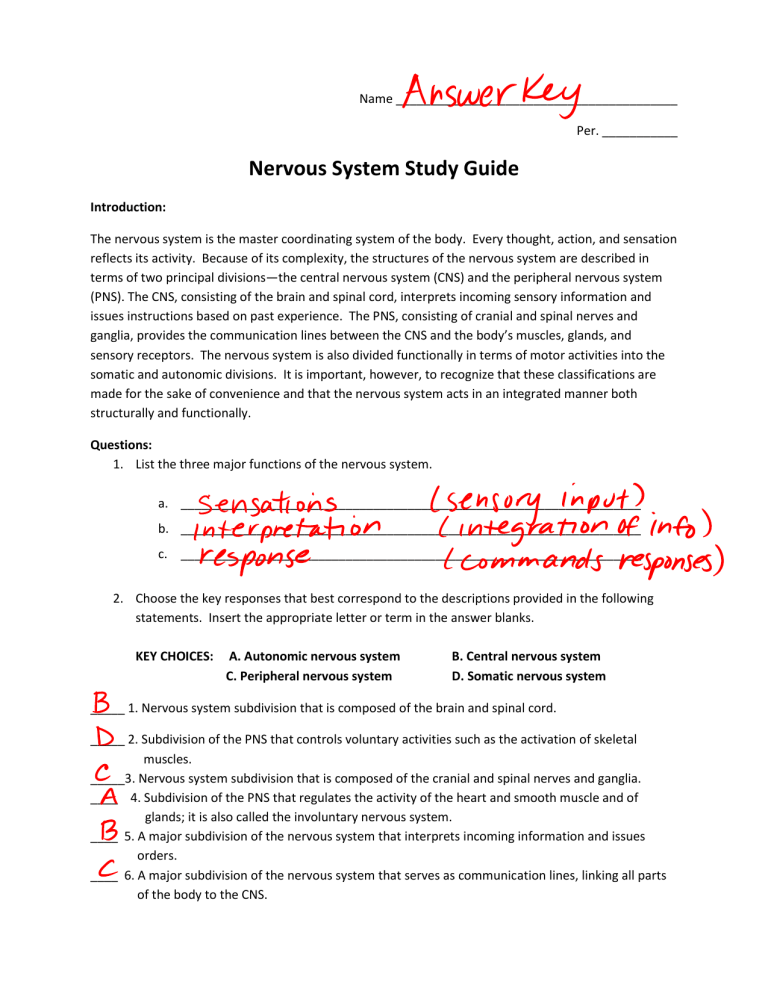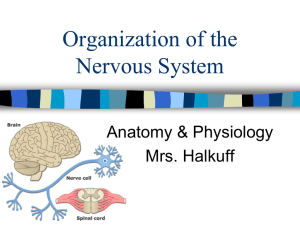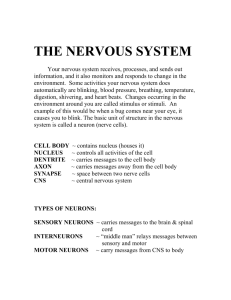Nervous System Study Guide: Anatomy and Function

Name _________________________________________
Per. ___________
Nervous System Study Guide
Introduction:
The nervous system is the master coordinating system of the body. Every thought, action, and sensation reflects its activity. Because of its complexity, the structures of the nervous system are described in terms of two principal divisions—the central nervous system (CNS) and the peripheral nervous system
(PNS). The CNS, consisting of the brain and spinal cord, interprets incoming sensory information and issues instructions based on past experience. The PNS, consisting of cranial and spinal nerves and ganglia, provides the communication lines between the CNS and the body’s muscles, glands, and sensory receptors. The nervous system is also divided functionally in terms of motor activities into the somatic and autonomic divisions. It is important, however, to recognize that these classifications are made for the sake of convenience and that the nervous system acts in an integrated manner both structurally and functionally.
Questions:
1.
List the three major functions of the nervous system. a.
___________________________________________________________________ b.
___________________________________________________________________ c.
___________________________________________________________________
2.
Choose the key responses that best correspond to the descriptions provided in the following statements. Insert the appropriate letter or term in the answer blanks.
KEY CHOICES: A. Autonomic nervous system
C. Peripheral nervous system
B. Central nervous system
D. Somatic nervous system
_____ 1. Nervous system subdivision that is composed of the brain and spinal cord.
_____ 2. Subdivision of the PNS that controls voluntary activities such as the activation of skeletal
muscles.
_____3. Nervous system subdivision that is composed of the cranial and spinal nerves and ganglia.
____ 4. Subdivision of the PNS that regulates the activity of the heart and smooth muscle and of
glands; it is also called the involuntary nervous system.
____ 5. A major subdivision of the nervous system that interprets incoming information and issues
orders.
____ 6. A major subdivision of the nervous system that serves as communication lines, linking all parts
of the body to the CNS.
3.
This exercise emphasizes the difference between neurons and neuroglia. Indicate which cell type is identified by the following descriptions. Insert the appropriate letter or term in the answer blanks.
KEY CHOICES: A. Neurons
____ 1. Supports, insulates, and protects cells.
B. Neuroglia
____ 2. Demonstrates irritability and conductivity, and thus transmit electrical messages from one area
of the body to another area.
____ 3. Release neurotransmitters.
____ 4. Are amitotic.
____ 5. Able to divide; therefore are responsible for most brain neoplasms.
4.
Match the anatomic terms given in Column B with the appropriate descriptions of the function provided in Column A. Place the correct term or letter response in the answer blanks.
Column A
____ 1. Releases neurotransmitters
Column B
A. axon
____ 2. Conducts electrical currents toward the cell body
____ 3. Increases the speed of impulse transmission
____ 4. Location of the nucleus
B. Axonal terminal
C. Dendrite
D. Myelin sheath
____ 5. Generally conducts impulses away from the cell body E. Cell body
5.
Certain activities or sensations are listed below. Using key choices, select the specific receptor type that would be activated by the activity or sensation described. Insert the correct term(s) or letter response(s) in the answer blanks. Note that more than one receptor type may be activated in some cases.
KEY CHOICES:
A.
Bare nerve endings (pain)
C. Meissner’s corpuscle
Activity or Sensation
Walking on Hot Pavement
Feeling a pinch
Leaning on a shovel
B. Golgi tendon organ
D. Muscle spindle
Receptor Type
E. Pacinian corpuscle
1. (Identify two) ________________________________
And ___________________________________
2. (Identify two) ________________________________
And ___________________________________
3. ___________________________________________
Muscle sensations when rowing a boat 4. (Identify two) _______________________________
And ___________________________________
Feeling a caress 5. ___________________________________________
6.
List in order the minimum elements in a reflex arc from the stimulus to the activity of the effector. Place your responses in the answer blanks.
1. Stimulus 2. __________________________ 3. ____________________________
4. ______________________________ 5. Effector organ
7.
Using key choices, select the terms indentified in the following descriptions by inserting the appropriate letter or term in the spaces provided.
KEY CHOICES:
A.
Afferent neuron
B.
Association neuron
E.
Ganglion
F. Neuroglia
G. Neurotransmitters
C.
Cutaneous sense organs H. Nerve
D.
Efferent neuron I. Nodes of Ranvier
J. Nuclei
K. Proprioceptors
L. Schwann cells
M. Synapse
N. Stimuli
O. Tract
____ 1. Sensory receptors found in the skin, which are specialized to detect temperature, pressure
changes, and pain.
____ 2. Specialized cells that myelinate the fibers of neurons found in the PNS
____ 3. Junction or point of close contact between neurons.
____ 4. Bundle of nerve processes inside the CNS.
____ 5. Neuron, serving as part of the conduction pathway between sensory and motor neurons
____ 6. Gaps in a myelin sheath
____ 7. Collection of nerve cell bodies found outside the CNS
____ 8. Neuron that conducts impulses away from the CNS to muscles and glands
____ 9. Sensory receptors found in muscle and tendons that detect their degree of stretch.
____ 10. Changes, occurring within or outside the body, that affect nervous system functioning.
____ 11. Neuron that conducts impulses toward the CNS from the body periphery.
____12. Chemicals released by neurons that stimulate other neurons, muscles, or glands.
8.
Figure 7-1 is a diagram of a neuron. First, label the parts indicated on the illustration by leader lines. Then choose different colors for each of the structures listed below and use them to color in the coding circles and corresponding structures in the illustration. Finally, draw arrows on the figure to indicate the direction of impulse transmission along the neuron’s membrane.
9.
Using the key choices, identify the types of reflexes involved in each of the following situations.
KEY CHOICES: A. Somatic Reflex(es)
____ 1. Patellar (knee-jerk) response
B. Autonomic reflex(es)
____ 2. Pupillary light reflex
____ 3. Effectors are skeletal muscles
____ 4. Effectors are smooth muscle and glands
____ 5. Flexor reflex
____ 6. Regulation of blood pressure
____ 7. Salivary reflex
10.
Refer to Figure 7-2, showing a reflex arc, as you complete this exercise. First, briefly answer the following questions by inserting your responses in the spaces provided. a.
What is the stimulus? _____________________________________________________ b.
What tissue is the effector? ________________________________________________ c.
How many synapses occur in this reflex arc? ___________________________________
Next, select different colors for each of the following structures and use them to color in the coding circles and corresponding structures in the diagram. Finally, draw arrows on the figure indicating the direction of the impulse transmission through this reflex pathway.
11.
Using the key choices, complete the following statements by inserting your answers in the answer blanks.
KEY CHOICES: A. ventricles B. cerebral hemispheres
D. cerebrospinal fluid
C. brain stem
E. cerebellum
The largest part of the human brain is the (paired) _________________________________.
The other major subdivisions of the brain are the __________________________________ and the __________________________________. The cavities found in the brain are called
_____________________________and they contain ________________________________.
12.
Using the Key Choices, complete the following statements.
KEY CHOICES: A. myelinated fibers B. Surface area
D. gyrus
C. Neuron cell bodies
A _____________ is an elevated ridge of cerebral cortex tissue. The convolutions seen in the cerebrum are important because they increase the ________________________. Gray matter is composed of _________________________. White matter is composed of ______________, which provide for communication between different parts of the brain as well as with lower CNS centers.
13.
Figure 7-3 is a diagram of the right lateral view of the human brain. First, match the letters on the diagram with the following list of terms and insert the appropriate letters in the answer blanks. Then, select different colors for each of the areas of the brain provided with a colorcoding circle and use them to color in the coding circles and corresponding structures in the diagram. If an identified area is a part of a lobe, use the color you selected for the lobe but use stripes for that area.
14.
Figure 7-4 is a diagram of the sagittal view of the human brain. First match the letters on the diagram with the following list of terms and insert the appropriate letter in the answer blanks.
Then, color the brain-stem areas blue and the areas where cerebrospinal fluid is found yellow.
______1. Cerebellum
______2. Cerebral Aqueduct
______3. Cerebral hemisphere
______4. Cerebral Peduncle
______5. Choroid plexus
______6. Corpora quadrigemina
______7. Corpus callosum
______8. Fourth ventricle
_______9. Hypothalamus
______10. Medulla oblongata
______11. Optic chiasma
______12. Pineal body
______13. Pituitary body
______14. Pons
______15. Thalamus
15.
If the following statements are true, insert the word “true” in the answer blanks. If any of the statements are false, correct the underlined term by inserting the correct term in the answer blank.
________________1.Cortical areas involved in audition are found in the occipital lobe.
________________2. The primary motor area in the temporal lobe is involved in the initiation of
voluntary movements.
________________3. The right cerebral hemisphere receives sensory input from the right side
of the body.
________________4. Damage to the thalamus impairs consciousness and the awake/sleep
cycles.
________________5. A flat EEG is evidence of clinical death.
________________6. Brain imaging with an MRI involves the use of radioisotope tracers.
16.
Using the following KEY choices, identify the meningeal (or associated) structures described below.
KEY CHOICES: A. Arachnoid layer
___________1. Outermost covering of the brain, composed of tough fibrous connective
tissue.
B. Pia mater C. Dura mater D. ventricles
___________2. Innermost covering of the brain; delicate and vascular.
___________3. Structures that return cerebrospinal fluid to the venous blood in the dura
l sinuses.
___________4. Middle meningeal layer; like a cobweb in structure.
___________5. Its outer layer forms the periosteum of the skull.
17.
Application of Knowledge . You have been given all of the information needed to identify the brain regions involved in the following situations. See how well your nervous system has integrated this information, and name the brain region (or condition) most likely to be involved in each situation. Place your responses in the answer blanks. a.
Following a train accident, a man with an obvious head injury was observed stumbling about the scene. An inability to walk properly and a loss of balance were quite obvious.
What brain region was injured? Explain b.
An elderly woman is admitted to the hospital to have a gallbladder operation. While she is being cared for, the nurse notices that she has trouble initiating movement and has a strange “pill-rolling” tremor of her hands. What cerebral area is most likely involved?
Explain
c.
A child is brought to the hospital with a high temperature. The doctor states that the child’s meninges are inflamed. What name is given to this condition? Where are the meninges located? d.
A young woman is brought into the emergency room with extremely dilated pupils. Her friends state that she has overdosed on cocaine. What cranial nerve is stimulated by the drug? e.
A young man has just received serious burns, resulting from standing with his back too close to a bonfire. He is muttering that he never felt the pain. Otherwise, he would have smothered the flames by rolling on the ground. What part of his CNS might be malfunctional? f.
An elderly gentleman has just suffered a stroke. He is able to understand verbal and written language, but when he tries to respond, his words are garbled. What cortical region has been damaged by the stroke? Explain. g.
A 12-year old boy suddenly falls to the ground, having an epileptic seizure. He is rushed to the emergency room of the local hospital for medication. His follow-up care includes a recording of his brain waves to try to determine the area of the lesion. What is this procedure called?
18.
Figure 7-6 is a cross-sectional view of the spinal cord. First, select different colors to identify the following structures and use them to color the coding circles and corresponding structures in the figure.
Pia mater Dura mater Arachnoid
Then, identify the areas listed in the key choices by inserting the correct choices/letter next to the appropriate leader line on the figure.
KEY CHOICES:
A. Central canal D. Dorsal root
B. Column of white matter E. Dorsal root ganglion
C. Dorsal horn F. Spinal nerve
G. Ventral Horn
H. Ventral Root
19.
Using the KEY Choices, indicated what would happen if the following structures were damaged or transected. Place the correct letter in the answer blanks.
KEY CHOICES:
A. Loss of motor function
B. Loss of sensory function
_______1. Dorsal root of a spinal nerve
C. Loss of both motor and sensory function
_______2. Ventral root of a spinal nerve
_______3. Anterior ramus of a spinal nerve
20.
The following table indicates a number of conditions. Use a check to show which division of the autonomic nervous system is involved in each condition.
Condition Sympathetic Parasympathetic
Postganglionic neurons secrete norepinephrine; adrenergic fibers
Postganglionic neurons secrete acetylcholine; cholinergic fibers
Normally in control
Fight or Flight response system
Causes a dry mouth, dilates bronchioles
Constricts eye pupils, decreases heart rate
Slows down digestive functions
21.
You are alone in your home late in the evening, and you hear an unfamiliar sound in your backyard. In the spaces provided, list four physiologic events promoted by the sympathetic nervous system that would help you to cope with this frightening situation. a.
________________________________________________________________________ b.
________________________________________________________________________ c.
________________________________________________________________________ d.
________________________________________________________________________
22.
After surgery, patients are often temporarily unable to urinate, and bowel sounds are absent. Indentify the division of the autonomic nervous system that is affected by anesthesia.
Explain.
23.
A brain tumor is found in a CT scan of Mr. Child’s head. The physician is assuming that it is not a secondary tumor (i.e. it did not spread from another part of the body) because an exhaustive workup has revealed no signs of cancer elsewhere in Mr. Child’s body. Is the brain tumor more likely to have developed from nerve tissue or from neuroglia? Why?
24.
Amy, a high-strung teenager, was suddenly startled by a loud bang that sounded like a gunshot. Her heartbeat accelerated rapidly. When she realized that the noise was only a car backfiring, she felt greatly relieved but her heart kept beating heavily for several minutes more.
Why does it take a long time to calm down after we are scared?
25.
While working in the emergency room, you admit two patients who were in an auto collision.
One is dead on arrival, having sustained a severed spinal cord at the level of C2. The other patient suffered a similar injury but at the level of C6 and is still alive. Explain briefly, in terms of the origin and function of the phrenic nerves, why one injury was fatal and the other was not.








